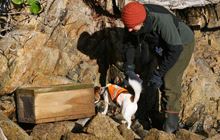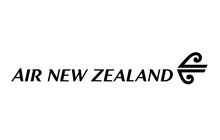Conservation Dogs Programme
Introduction
The Conservation Dogs Programme mentors, certifies and supports a nationwide network of dog-handler teams. These teams detect New Zealand’s protected species or unwanted pests.Certified conservation dogs are a highly effective tool to support our conservation goals. Across Aotearoa there are over 120 certified conservation dogs. They work with their dog handlers to support DOC, councils, community groups, researchers, iwi, hapū, whānau, and others to do important work for our native ecosystems.
Certified dog and handler teams:
- locate threatened species to support conservation work
- undertake biosecurity checks at areas where vehicles leave for pest free islands
- carry out surveillance checks of pest free areas to make sure no pests have arrived
- assist in pest incursion responses to quickly find and remove any pests
- educate people on New Zealand’s nature and the role trained dogs can play.
Image gallery
-
Vito, an Argentine ant detection dog checks a shipment to a pest-free island Image: Adeline Bosman | DOC
![Vito, an Argentine ant detection dog checks a shipment to a pest-free island. Vito, an Argentine ant detection dog checks a shipment to a pest-free island.]()
-
Dog-handler teams attending a training camp. Image: Helen Neale | DOC
![Dog-handler teams attending a training camp. Dog-handler teams attending a training camp.]()
-
Indie, a rodent detection dog, working on pest-free Oruawairua/Blumine Island Image: Hannah Irwin | DOC
![Indie, a rodent detection dog, working on pest-free Oruawairua/Blumine Island. Indie, a rodent detection dog, working on pest-free Oruawairua/Blumine Island.]()
-
Pru, a rodent detection dog, at work Image: | DOC
![Little dog, Pru, a rodent detection dog, at work. Little dog, Pru, a rodent detection dog, at work.]()
-
DOC Conservation dog handler Adeline with her dog, Blaze and Meghan, Air NZ flight attendant Image: Air New Zealand | DOC
![DOC Conservation dog handler Adeline with her dog, Blaze and Meghan, Air NZ flight attendant. DOC Conservation dog handler Adeline with her dog, Blaze and Meghan, Air NZ flight attendant.]()
Pest detection dogs
Pest detection dogs uncover the presence of target pests, such as stoats, rodents, plague skinks and Argentine ants. They smell and indicate scat (faeces), urine, ground scent, and live and dead animals.
Pest detection dogs carry out inspections before boats leave the mainland to pest free islands. This includes checking people, luggage, items and vehicles travelling to pest free islands. They also visit pest free areas regularly to do surveillance sweeps.
Their highly trained noses help conservation teams to quickly find and remove predators from pest free islands and sanctuaries. This is vital work because many of our native and taonga (treasure) species can only thrive when free from predation by introduced pests.
Conservation dogs can also train to detect invasive weeds and plant pathogens, such as spartina, velvet leaf and Chilean needle grass, and the pathogen that causes kauri dieback disease. Weeds and pathogens can devastate ecosystems affecting native plants and the animals that rely on them.
As more parts of New Zealand become predator free by 2050, pest detection dogs will be key in helping to keep areas predator free.
Protected species detection dogs
Protected species detection dogs help us to manage populations of endangered species. These dogs help us locate species, for example kiwi, so we can monitor them and carry out health checks. They help find species so we can transport them to other areas in New Zealand to establish new populations.
Highly trained dog-handler teams have played a major role in the conservation of species such as kiwi, whio/blue duck, pāteke/brown teal, takahē and kākāpō.
Air New Zealand is our national partner
Air New Zealand is the national partner for the Conservation Dogs Programme. The wings beneath this work, Air New Zealand’s investment helps us run something truly world-class.
With their support we offer mentoring, training and certification to dog handler-teams around New Zealand. Their support allows DOC’s core programme team to work in the field detecting pests and finding threatened species.
Air New Zealand also helps raise awareness for biodiversity by sharing stories of our partnership conservation efforts For over 10 years Air New Zealand has flown our certified conservation dogs to the precious places they enhance.
Certification and training
New Zealand was the first country to use dogs to benefit conservation with Richard Henry pioneering this work in the 1890’s. Well trained dog-handler teams have worked more extensively in conservation since the 1980s.
Today our Conservation Dogs Programme is recognised as world leading for its national standards for the safe and effective use of conservation dogs.
Our programme certifies and provides ongoing training and support to teams throughout Aotearoa. Handlers can be DOC staff, staff from other organisations and individuals. Conservation Dogs Programme dog-handlers are skilled and experienced in wildlife management and pest control.
It takes around 18 months of daily training for dog-handler teams to become certified for their target species. Once certified, conservation dogs need to train several times a week for the duration of the dog’s working life. This is around a decade.
A certified dog meets a high standard of obedience and control. They demonstrate a proven ability to detect their target species and associated scents, for example scat, urine or feathers.
Certified conservation dogs wear vests and muzzles when they are working on public conservation land or in any area where protected species live, such as beaches and dunes.
National standards and protocols exist for all conservation dog-handler teams when they:
- work on DOC-administered land
- work on private land where a DOC permit is required to handle protected species, or
- are looking for pests in areas where there are protected species.
Find out more about the programme processes and operating procedures
Advocacy and education
Globally, New Zealand is considered a leader in pest eradication programmes. Conservation dogs are a key tool in these programmes.
We have supported the UK and Australia with rodent detection dogs to remove pests from islands. In the Pacific islands we have supported work to protect seabirds. We also helped Japan in building their own conservation dogs programme for invasive species such as mongoose.
Conservation dogs are a great way to spark conversations about threats to nature and wildlife. We often speak to the public and media about the work our dogs do and why this helps protect native species.
Our teams have starred on TVNZ’s Dog Squad television series, which showcases the importance of working dogs.
Other working dogs and pet dogs
Dogs that are not trained and handled correctly are a serious risk to protected species.
Companion dogs, working dogs, hunting dogs or those that live close to protected wildlife, such as a remote area or lifestyle block, can disturb or kill native birds. Avian avoidance training teaches dogs to avoid ground-dwelling native birds.
We encourage pet owners to learn about responsible dog ownership with our Lead the Way programme. Responsible dog owners keep their dogs under control or on a lead when they are in wildlife areas.








